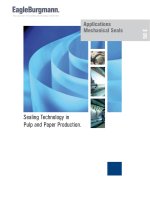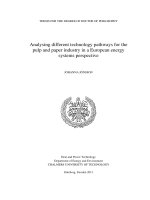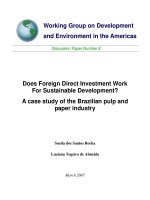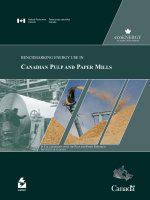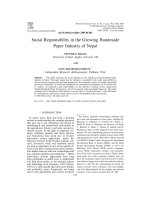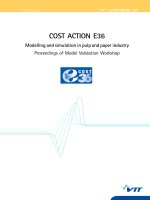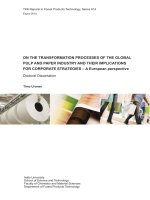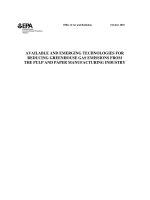Energy Cost Reduction in the Pulp and Paper Industry – An Energy Benchmarking Perspective docx
Bạn đang xem bản rút gọn của tài liệu. Xem và tải ngay bản đầy đủ của tài liệu tại đây (802.83 KB, 30 trang )
D.W. Francis, M.T. Towers and T.C. Browne
Pulp and Paper Research Institute of Canada
(Paprican)
Energy Cost Reduction
in the Pulp and
Paper Industry
– An Energy Benchmarking Perspective
5
Energybk imega couverts-2001 2 aout.prn
S:\25784\Energybk imega couverts-2001 2 aout.cdr
17 juin, 2003 11:37:18
Color profile: Generic CMYK printer profile
Composite 133 lpi at 45 degrees
The Office of Energy Efficiency of Natural Resources Canada
strengthens and expands Canada’s commitment to energy efficiency
in order to help address the challenges of climate change.
Leading Canadians to Energy Effic iency at Home, at Work and on the Ro ad
6
Energybk imega couverts-2001 2 aout.prn
S:\25784\Energybk imega couverts-2001 2 aout.cdr
17 juin, 2003 11:37:18
Color profile: Generic CMYK printer profile
Composite 133 lpi at 45 degrees
S:\25784\English\Energybk-e imega.vp
14 mars, 2003 11:34:24
Color profile: Generic CMYK printer profile
Composite Default screen
S:\25784\English\Energybk-e imega.vp
14 mars, 2003 11:34:24
Color profile: Generic CMYK printer profile
Composite Default screen
TABLE OF CONTENTS
INTRODUCTION . . . . . . . . . . . . . . . . . . . . . . . . . 5
THE MODEL KRAFT MARKET PULP MILL . . . . . . . . . . 6
Conveying Chips . . . . . . . . . . . . . . . . . . . . . . . . . . . . 7
Digester . . . . . . . . . . . . . . . . . . . . . . . . . . . . . . . . . 7
Washing and Screening . . . . . . . . . . . . . . . . . . . . . . . . . 7
Oxygen Delignification . . . . . . . . . . . . . . . . . . . . . . . . . 8
Bleaching . . . . . . . . . . . . . . . . . . . . . . . . . . . . . . . . 8
Pulp Machine . . . . . . . . . . . . . . . . . . . . . . . . . . . . . . 8
Black Liquor Evaporation . . . . . . . . . . . . . . . . . . . . . . . . 9
Power Plant . . . . . . . . . . . . . . . . . . . . . . . . . . . . . . . 9
Lime Kiln and Recausticizing . . . . . . . . . . . . . . . . . . . . . . 9
Hot Water System . . . . . . . . . . . . . . . . . . . . . . . . . . . 10
Waste-Water Treatment . . . . . . . . . . . . . . . . . . . . . . . . 10
Miscellaneous . . . . . . . . . . . . . . . . . . . . . . . . . . . . . 10
ENERGY CONSUMPTION IN EXISTING AND MODEL
KRAFT MARKET PULP MILLS . . . . . . . . . . . . . . . . 10
THE MODEL NEWSPRINT MILL . . . . . . . . . . . . . . . 14
Thermomechanical Pulp Mill . . . . . . . . . . . . . . . . . . . . . 15
Recycled Fibre Mill . . . . . . . . . . . . . . . . . . . . . . . . . . 16
Paper Machine . . . . . . . . . . . . . . . . . . . . . . . . . . . . . 16
Effluent Treatment . . . . . . . . . . . . . . . . . . . . . . . . . . . 16
Integrated Newsprint Mill . . . . . . . . . . . . . . . . . . . . . . . 17
ENERGY CONSUMPTION IN EXISTING AND MODEL
NEWSPRINT MILLS . . . . . . . . . . . . . . . . . . . . . . . 20
ENERGY COST REDUCTION IN EXISTING MILLS . . . . . 22
Management Overview . . . . . . . . . . . . . . . . . . . . . . . . 22
Process Analysis and Energy Optimization . . . . . . . . . . . . . . 23
Processes and Process Equipment . . . . . . . . . . . . . . . . . . . 24
Energy Purchasing Strategies . . . . . . . . . . . . . . . . . . . . . 24
Project Identification and Selection . . . . . . . . . . . . . . . . . . 25
Continuous Performance Monitoring and Improvement . . . . . . . 26
CONCLUSION . . . . . . . . . . . . . . . . . . . . . . . . . . 26
REFERENCES . . . . . . . . . . . . . . . . . . . . . . . . . . 28
S:\25784\English\Energybk-e imega.vp
14 mars, 2003 11:34:25
Color profile: Generic CMYK printer profile
Composite Default screen
LIST OF FIGURES
Figure 1. Process steam consumption – kraft mills . . . . . . . . 11
Figure 2. Process electricity consumption – kraft mills. . . . . . 11
Figure 3. Purchased fossil fuel demand – kraft mills. . . . . . . 12
Figure 4. Net electricity demand – kraft mills. . . . . . . . . . . 13
Figure 5. Process steam consumption – newsprint mills. . . . . . 20
Figure 6. Process electricity consumption – newsprint mills. . . 20
Figure 7. Purchased fossil fuel demand – newsprint mills. . . . . 21
LIST OF TABLES
Table I. Modern Kraft Market Pulp Mill –
Steam and Electricity Consumption . . . . . . . . . . 7
Table II. Modern Kraft Market Pulp Mill –
Steam and Electricity Generation . . . . . . . . . . . 7
Table III. Modern Kraft Market Pulp Mill –
Purchased Energy Required . . . . . . . . . . . . . . 7
Table IV. TMP Mill –
Steam and Electricity Consumption . . . . . . . . . 15
Table V. Newsprint Paper Machine –
Steam and Electricity Consumption . . . . . . . . . 16
Table VI. Modern Newsprint Mill –
Steam and Electricity Consumption . . . . . . . . . 18
Table VII. Modern Newsprint Mill –
Energy Consumption . . . . . . . . . . . . . . . . . 18
S:\25784\English\Energybk-e imega.vp
14 mars, 2003 11:34:25
Color profile: Generic CMYK printer profile
Composite Default screen
Energy Cost Reduction in the
Pulp and Paper Industry
D.W. Francis, M.T. Towers and T.C. Browne
Pulp and Paper Research Institute of Canada (Paprican)
INTRODUCTION
Energy use reduction can provide cost savings, often with low capital
investment. It is a complex task, but is accessible to non-specialists
with appropriate training. The Pulp and Paper Technical Association
of Canada (PAPTAC) has prepared a short course on energy efficiency
in the pulp and paper industry. This document discusses the motivation
for developing an energy efficiency program and provides an outline
of the course contents. In particular, it addresses two questions:
1. What is the potential for energy use reduction in pulp and paper
mills?
2. How can this potential energy use reduction be achieved?
Benchmarking provides a means to determine the potential for
energy reduction. A benchmarking study is a comparison of
the competitive situation among similar types of mills
producing the same product [1]. The energy use for a
particular mill can be compared with that for sim
-
ilar mills or with that for a model mill repre
-
senting the current best practice.
To illustrate the potential to reduce
energy consumption and greenhouse
gas (GHG) emissions, bench
-
marking studies were performed
for the two largest production
segments of the Canadian pulp
5
Energy Cost Reduction in the Pulp and Paper Industry
S:\25784\English\Energybk-e imega.vp
14 mars, 2003 11:34:26
Color profile: Generic CMYK printer profile
Composite Default screen
and paper industry: kraft market pulp and newsprint. In each case the
energy consumption for a modern mill was determined using current
proven technology and compared with that for existing Canadian mills
[2].
THE MODEL KRAFT MARKET PULP MILL
The model kraft market pulp mill produces fully bleached market pulp
from wood chips transported from local sawmills. It utilizes the most
energy-efficient unit operations that have been proven technically fea
-
sible. The power boiler uses hog fuel, and condensing-extracting
steam turbines are used to produce electricity. The total liquid effluent
from the mill would be approximately 35 m
3
/Airdried tonne (ADt).
The energy consumption for the model mill is shown in Table I; the
energy production is shown in Table II; and the purchased energy con
-
sumption is shown in Table III. The process design for the model mill
is described in detail below.
Conveying Chips
It is assumed that chips are purchased from sawmill operations. Belt
conveyers would be used to transfer the wood chips from the chip piles
to the pre-steaming vessel. Heat from black liquor flash tanks is used to
preheat chips in the pre-steaming vessel; thus, no live steam is
required. The electricity requirement for the conveying operations is
estimated at 20 kWh/ADt [3].
Digester
The cooking process for a modern kraft mill would be modified con
-
tinuous cooking (MCC) in a Kamyr digester. The target Kappa
number (for softwood) would be 30 to preserve wood yield.
Live steam requirement for this process would be
1.7 GJ/ADt [3], and the total electricity demand would be
40 kWh/ADt [3].
6
S:\25784\English\Energybk-e imega.vp
14 mars, 2003 11:34:29
Color profile: Generic CMYK printer profile
Composite Default screen
Energy Cost Reduction in the Pulp and Paper Industry
7
Table I. Modern Kraft Market Pulp Mill – Steam and
Electricity Consumption
Steam Electricity
GJ/ADt kWh/ADt
Chip conveying 0.0 20
Digester 1.7 40
Washing and screening 0.0 30
Oxygen delignification 0.5 75
Bleaching 2.3 100
Pulp machine 2.3 141
Black liquor evaporators 3.1 30
Power plant 2.3 60
Kiln and recausticizing 0.0 50
Hot water supply 0.0 32
Waste-water treatment 0.0 30
Miscellaneous 0.0 30
Total Consumption 12.2 638
Table II. Modern Kraft Market Pulp Mill – Steam and
Electricity Generation
Steam Electricity
GJ/ADt kWh/ADt
Recovery boiler 15.8 655
Total Generation 15.8 655
Table III. Modern Kraft Market Pulp Mill – Purchased
Energy Required
Steam Electricity Natural Gas
GJ/ADt kWh/ADt GJ/ADt
Amount purchased (excess) 0.0 (17) 1.2
S:\25784\English\Energybk-e imega.vp
14 mars, 2003 11:34:30
Color profile: Generic CMYK printer profile
Composite Default screen
Washing and Screening
High-efficiency washers, such as pressure filters, are employed for
brownstock washing. Inlet consistencies for these washers is about
4 percent, more than double that of a conventional vacuum drum
washer, which reduces the amount of vat dilution to be pumped. How
-
ever, the blower required to pressurize the washer consumes the elec
-
trical energy savings. The net result is better washing for
approximately the same energy requirement. The screen room is
closed, and screening is done at 5 percent consistency. The higher con
-
sistency reduces pumping requirements. Condensate from the mill's,
black liquor evaporators is used as wash water. No live steam is
required for washing and screening. The electricity requirement is esti
-
mated to be 30 kWh/ADt [3].
Oxygen Delignification
Oxygen delignification is used to further delignify the pulp prior to
bleaching. Approximately 60 percent delignification is achieved in
two stages. Two stages of post-oxygen washing are required; twin roll
presses would be used. The live steam required to heat the oxygen
stages would be 0.5 GJ/ADt [3], and the electricity required for the
area would be 75 kWh/ADt.
Bleaching
A modern mill is able to achieve fully bleached pulp from a four-stage
elemental chlorine free (ECF) bleach plant. A D
0
E
o
D
N
D bleaching
sequence is used. High-efficiency pressure filters are used for washing
between bleaching stages. All stages are medium consistency to
reduce pumping requirements. The D
0
stage is at 60ºC and uses
0.96 percent ClO
2
on pulp. The E
o
stage is at 90ºC and uses
1.50 percent NaOH on pulp. The D
N
stage is at 70ºC and uses
0.75 percent ClO
2
on pulp. The D stage is at 70ºC and uses
0.20 percent ClO
2
on pulp.
All the ClO
2
is generated on-site from sodium chlorate
using the R10 process. NaOH is purchased. The
steam requirement for ClO
2
generation is
8
S:\25784\English\Energybk-e imega.vp
14 mars, 2003 11:34:32
Color profile: Generic CMYK printer profile
Composite Default screen
0.2 GJ/ADt [4]. The steam requirement for heating throughout the rest
of the bleach plant is about 2.1 GJ/ADt. The electricity requirement for
the bleach plant would be 100 kWh/ADt.
Pulp Machine
A double-wire press section is used to achieve 50 percent consistence
into the dryer section on the machine. This equipment has reduced
steam use to 2.3 GJ/ADt at one mill [3]. Electricity consumption was
reported at 141 kWh/ADt [3].
Black Liquor Evaporation
Weak black liquor is produced at 15 percent solids, which is then evap
-
orated to 78 percent solids using a seven-effect multiple-effect evapo
-
ration system with an integrated superconcentrator. Steam economy is
estimated at 6.0 kg water/kg steam for such an arrangement. The black
liquor contains 1.6 kg solids/kg pulp. The steam requirement for the
evaporators is calculated to be 3.1 GJ/ADt. The electricity requirement
would be 30.0 GJ/ADt [3].
Power Plant
The mill would use a high solids recovery boiler that achieves a 75 per-
cent heat-to-steam efficiency. Heating value of black liquor would be
approximately 6250 Btu/lb. solids (21.0 GJ/ADt pulp). The boiler air
is heated to 150ºC using steam, and minimal use of soot blowers is
employed, consuming 0.9 GJ/ADt of steam. The mill would recover
70 percent of steam condensate, and the resulting energy use in the
deaerator is 1.0 GJ/ ADt. Condensing-extracting steam turbines are
used to produce electricity with a power-to-heat ratio of
100 kWh/GJ. The mill’s power boiler uses hog fuel and
achieves a heat-to-steam efficiency of 70 percent. The mill
generates 15.8 GJ/ADt in the recovery boiler to satisfy
the heat requirements of the process and electricity
generation needs. A backpressure steam turbine
generates 520 kWh/ADt of electricity, while
excess high-pressure steam generates
Energy Cost Reduction in the Pulp and Paper Industry
9
S:\25784\English\Energybk-e imega.vp
14 mars, 2003 11:34:34
Color profile: Generic CMYK printer profile
Composite Default screen
another 135 kWh/ADt through a steam-condensing turbine. Therefore,
the total electricity generation by the mill is 655 kWh/ADt. The power
plant has a parasitic electricity need of about 60 kWh/ADt [3].
Lime Kiln and Recausticizing
The kiln utilizes flash drying and product coolers to minimize energy
consumption. Natural gas is used to provide the 1.2 GJ/ADt of heat
energy required. Pressure filters are used for solids separation from
process liquors. Electricity requirements will be 50 kWh/ADt [3].
Hot Water System
Warm water (50ºC) is produced through heat recovery in the evapo
-
rator condensers. Hot water (70
o
C) is produced through heat recovery
from the digester surface condenser, cold blow liquor cooling and
black liquor cooling. Hot water for use on the pulp machine will be
generated using heat recovery from the dryer section. Electricity
requirements are 32 kWh/ADt.
Waste-Water Treatment
Mill effluent is treated in a primary clarifier and secondary activated
sludge basin. Total mill effluent is 35 m
3
/ADt. A cooling tower is
required to remove process heat. Electricity requirements are
30 kWh/ADt for aeration and pumping.
Miscellaneous
This includes HVAC, lighting, office use, etc. No live steam is
required. The electricity requirement is approximately 30 kWh/ADt.
ENERGY CONSUMPTION IN EXISTING AND
MODEL KRAFT MARKET PULP MILLS
There are many ways to compare mill energy consump
-
tion in benchmarking studies. We will look at two
methods for kraft market pulp mills: process
energy consumption and energy purchases. The
first provides a measure of the specific energy
10
S:\25784\English\Energybk-e imega.vp
14 mars, 2003 11:34:35
Color profile: Generic CMYK printer profile
Composite Default screen
used in pulp and paper manufacturing. The
second is influenced by this process
energy consumption and also by how
that energy is supplied to the
Energy Cost Reduction in the Pulp and Paper Industry
11
Figure 1. Process steam consumption – kraft mills
Figure 2. Process electricity consumption – kraft mills
S:\25784\English\Energybk-e imega.vp
14 mars, 2003 11:34:37
Color profile: Generic CMYK printer profile
Composite Default screen
manufacturing operations. It provides a measure of the costs for
energy, both economic and environmental.
The process steam and electricity consumptions for Canadian kraft
market pulp mills are shown in Figures 1 and 2. The steam and elec-
tricity consumptions were calculated from data in the CPPA Energy
Monitoring Report for 1999 [2]. The kraft mills are grouped according
to the time since their last major modernization. Also shown are the
steam and electricity requirements for the model kraft mill.
The data in Figures 1 and 2 show that both older and modernized mills
have greater energy consumption than the modern mill. Also, there is
little difference in the energy consumption for older and modernized
kraft mills. The first and third quartile steam consumption for
older mills is only slightly higher than that for modernized
mills; the electricity consumption for older mills is slightly
lower than that for modernized mills. Some of the older
12
0
2
4
6
8
10
12
14
1 2 3 4 5 6 7 8 9 10 11 12 13 14 15 16 17 18 19 20 21 22 23 24 25 26 27
Mills sorted by fossil fuel demand
–
Purchased Fossil Fuel (GJ/t)
Q3
Q1
Modern
Mill
Figure 3. Purchased fossil fuel demand – kraft mills
S:\25784\English\Energybk-e imega.vp
14 mars, 2003 11:34:38
Color profile: Generic CMYK printer profile
Composite Default screen
facilities are among the lowest overall consumers of process steam and
electricity. Thus, new and modernized mills are not achieving the
optimum energy consumption levels possible for a modern mill.
The fossil fuel and electricity purchases for kraft mills are shown in
Figures 3 and 4. The energy purchases are generally higher than those
for the modern mill for two reasons. First, the specific energy used in
pulp and paper manufacturing is higher than for the modern mill.
Second, how that energy is provided influences the amount of energy
purchased. The lower amount of process steam required by the modern
mill enables excess steam to be used in a steam-condensing turbine to
generate more electricity than a conventional process.
The modern mill uses fossil fuel primarily for the operation of
the lime kiln, 1.20 GJ/ADt. Some fossil fuel would also be
required for startup of the recovery boiler after a shut
-
down, but this amount would be very small. The
mill would also have a fossil fuel powered
13
Energy Cost Reduction in the Pulp and Paper Industry
-200
0
200
400
600
800
1000
1200
1 2 3 4 5 6 7 8 9 10 11 12 13 14 15 16 17 18 19 20 21 22 23 24 25 26 27
Mills sorted by electricity demand
–
Net Electricity (kWh/t)
Q3
Q1
Modern
Mill
Figure 4. Net electricity demand – kraft mills
S:\25784\English\Energybk-e imega.vp
14 mars, 2003 11:34:40
Color profile: Generic CMYK printer profile
Composite Default screen
package boiler to provide steam as required during periods of major
upset or transition. The average Canadian kraft mill purchased
5.99 GJ/ADt of fossil fuel in 1999, consisting of 4.24 GJ/ADt of nat
-
ural gas and 1.75 GJ/ADt of fuel oil and other fossil fuels. Assuming a
cost of $3.40/GJ for natural gas and $4.03/GJ for fuel oil, the modern
mill has $17.39/ADt lower fossil fuel costs than the average Canadian
mill.
The modern mill produces all its electricity requirements by steam-
condensing and backpressure turbines, with a slight excess of
17 kWh/ADt. There is a large variation in the electricity purchases in
Figure 4, resulting from large variations in the amount of power gener
-
ated by mills. The average electricity purchase was 272 kWh/ADt.
Assuming a cost of $0.04/kWh for electricity, the modern mill has
$11.56/ADt lower electricity costs than the average Canadian mill.
Thus, there is considerable potential for operating cost savings by opti
-
mizing energy usage in kraft market pulp mills. Possible savings for an
individual mill can be quickly estimated. First, select a benchmark
target; we recommend selecting a target from Figures 1 and 2 midway
between the first quartile and modern mill optimum performance for
both process steam and electricity. Subtract these figures from the cur-
rent consumption levels and multiply by the incremental energy costs.
This quick reference can help mills to assign priority to energy
objectives.
THE MODEL NEWSPRINT MILL
The model newsprint mill consists of a pulp mill and paper machine
along with an effluent treatment facility. The fibre furnish for a
modern newsprint mill would consist of thermomechanical pulp
(TMP) and/or recycled fibre depending on the fibre availability
and market requirements. The energy requirements for
pulping and paper making operations are described in the
following sections.
14
S:\25784\English\Energybk-e imega.vp
14 mars, 2003 11:34:42
Color profile: Generic CMYK printer profile
Composite Default screen
Thermomechanical Pulp Mill
The energy consumption of a modern TMP mill is shown in Table IV.
The mill produces TMP for newsprint manufacture from softwood
chips. Jackson and Wild estimated the energy consumption for a 500
BDMT/D single-line TMP mill [5]. The total specific refining energy
was 2400 kWh/BDMT, which is typical for TMP from black spruce
chips for newsprint production [5]. For comparison, reference may be
made to a detailed industrial audit complied by Nygaard [6] for
Swedish TMP mills, mostly producing for newsprint. Average
external power demand for these mills was similar, about
2420 kWh/ADt.
TMP refining energy is affected by wood species; common Canadian
species such as pine require more energy than black spruce [7].
Refining energy is also sensitive to paper grade, with higher-quality
mechanical printing paper grades requiring higher energy. Though
there are new processes for reducing refining energy somewhat [8],
consistent industrial performance has not yet been achieved.
Heat recovery is used in modern TMP newsprint mills to recover
some of the refining energy in the form of clean pressurized
steam. The clean steam production in Table IV was calcu
-
lated for heat recovery of the steam from the mainline
and rejects refiners by a reboiler [5]. The estimated
steam production for the modern TMP mill,
5.5 GJ/ADt, is similar to the possible steam
15
Energy Cost Reduction in the Pulp and Paper Industry
Table IV. TMP Mill – Steam and Electricity Consumption
Steam Electricity
GJ/ADt kWh/ADt
Chip handling 40
Refiners 2160
Pumps, screens, agitators, blowers 240
Heat recovery -5.5 10
Total Consumption -5.5 2450
S:\25784\English\Energybk-e imega.vp
14 mars, 2003 11:34:44
Color profile: Generic CMYK printer profile
Composite Default screen
production calculated by Nygaard, 5.2 GJ/ADt, for the same specific
refining energy [6]. The average excess steam production for Swedish
TMP mills in 1994 was lower, about 4.4 GJ/ADt [6].
Recycled Fibre Mill
The electricity consumption of a modern recycled fibre mill producing
de-inked pulp (DIP) for newsprint manufacture is 400 kWh/ADt [3].
The average external power demand for Swedish recycled fibre mills
in 1994 was lower, about 330 kWh/ADt [6]. The steam consumption
of a modern recycled fibre mill is 0.8 GJ/ADt, taken from the model
recycled fibre mill in Nygaard [6]. The average fuel heat demand for
Swedish recycled fibre mills in 1994 was lower, about 0.3 GJ/ADt [6].
Paper Machine
The energy consumption for a modern newsprint paper machine is
shown in Table V [9]. The average electricity consumption for
Swedish newsprint paper mills in 1994 was higher, about
440 kWh/ADt [6]. Talja et al. measured 344 kWh/ADt electricity con-
sumption for a modern paper machine producing SC paper [10].
The steam needed for paper drying depends on the consis
-
tency of the web after the press section and the machine
efficiency. Nilsson et al. reported that the minimum
energy needed for drying from 50 to 90 percent con
-
sistency is 2.26 GJ/ADt of paper produced [3]. The
drying steam consumption of 3.4 GJ/ADt is
16
Table V. Newsprint Paper Machine – Steam and Electricity
Consumption
Steam Electricity
GJ/ADt kWh/ADt
Stock preparation 0.7 100
Forming, pressing 0.3 140
Drying, finishing, auxiliary systems 3.4 90
Total Consumption 4.4 330
S:\25784\English\Energybk-e imega.vp
14 mars, 2003 11:34:47
Color profile: Generic CMYK printer profile
Composite Default screen
equivalent to the steam needed to dry the web from 43 percent consis
-
tency, assuming 1.25 kg steam per kg of water evaporated [11] and
10 percent paper machine losses due to trim and machine breaks. Talja
et al. measured 2.71 GJ/ADt total steam consumption for a modern
paper machine producing SC paper [10].
Effluent Treatment
The effluent treatment consists of primary clarification and activated
sludge treatment. The electricity consumption for effluent treatment is
60 kWh/ADt [5].
Integrated Newsprint Mill
The energy consumption for three modern integrated newsprint mills
is shown in Table VI. The pulp furnish for the three mills are TMP,
DIP and 80 percent TMP+20 percent DIP. The recycled fibre content
of the TMP/DIP newsprint mill was chosen to match the average recy-
cled content of newsprint mills in the CPPA Energy Monitoring
Report [2].
The differences in steam and electricity consumption among the three
mills are related to the energy needed for pulping and heat recovery.
DIP production requires less energy than TMP production but does not
produce steam that can be recovered and re-used in the paper machine.
The potential clean steam production by heat recovery in the TMP
newsprint mill is greater than the paper machine steam requirement,
giving a net steam production of 1.1 GJ/ADt.
The energy consumption for the TMP newsprint and DIP newsprint
mills in Table VI is similar to that reported by Lähepelto, based on a
study made by Jaakko Pöyry [12]. The energy consumption
reported for a modern TMP newsprint mill was -1.33 GJ/ADt
heat and 2190 kWh/ADt electricity [12]. The difference in
electricity consumption is due to different specific
energies for TMP refining. The energy consumption
reported for a modern DIP newsprint mill was
5.27 GJ/ADt heat and 870 kWh/ADt elec
-
tricity [12].
17
Energy Cost Reduction in the Pulp and Paper Industry
S:\25784\English\Energybk-e imega.vp
14 mars, 2003 11:34:48
Color profile: Generic CMYK printer profile
Composite Default screen
The purchased energy consumption for the three modern integrated
newsprint mills is shown in Table VII. For the TMP newsprint mill, no
steam needs to be generated by burning fossil fuels during normal
TMP mill operation due to the excess steam produced by heat
recovery. However, a backup steam system including a package boiler
and steam accumulator is needed to provide process steam during
upset conditions [5]. It was assumed in Table VII that a natural gas
fired boiler would provide backup steam equivalent to 10 percent of
the paper machine steam consumption with a boiler efficiency of
85 percent.
The DIP newsprint mill requires steam since less energy is used for
pulping and there is no heat recovery. The steam can be pro
-
vided in two ways. First, fossil fuel and sludge could be
burned to produce steam. It was assumed in Table VII that
the steam would be provided by natural gas fired boiler
with a boiler efficiency of 85 percent. Alternatively, a
gas turbine cogeneration plant could produce steam
and electricity. Assuming a power-to-steam ratio
near 1:1, the cogeneration plant would produce
excess electricity that could be sold [13].
18
Table VII. Modern Newsprint Mill – Energy Consumption
TMP DIP 80% TMP +
20% DIP
Electricity, kWh/ADt 2840.0 790.0 2430.0
Fossil fuel, GJ/ADt 0.5 6.1 0.8
Table VI. Modern Newsprint Mill – Steam and Electricity
Consumption
TMP DIP 80% TMP
+ 20% DIP
Steam Electricity Steam Electricity Steam Electricity
GJ/ADt kWh/ADt GJ/ADt kWh/ADt GJ/ADt kWh/ADt
TMP -5.5 2450 -4.4 1960
DIP 0.8 400 0.2 80
Paper machine 4.4 330 4.4 330 4.4 330
Effluent treatment 60 60 60
Total -1.1 2840 5.2 790 0.2 2430
Consumption
S:\25784\English\Energybk-e imega.vp
14 mars, 2003 11:34:50
Color profile: Generic CMYK printer profile
Composite Default screen
The TMP/DIP newsprint mill supplies most of its steam requirement
by heat recovery under normal operating conditions. However, a
backup steam system is also needed to provide process steam during
upset conditions in the TMP mill. It was assumed in Table VII that a
natural gas fired boiler would provide 0.2 GJ/ADt continuous steam
and backup steam equivalent to 10 percent of the paper machine steam
consumption with a boiler efficiency of 85 percent.
The modern newsprint mill was assumed to have heat recovery of
mainline and reject refiners. Some mills may choose not to recover
reject refiner steam, increasing the steam demand from the power
boiler. This steam demand would be met by burning hog fuel and
sludge. In 1999, Canadian newsprint mills produced 3.97 GJ/ADt of
steam from hog fuel and sludge [2]. Thus, this lower heat recovery
would not necessarily increase the fossil fuel consumption and the
resulting GHG emissions.
ENERGY CONSUMPTION IN EXISTING AND MODEL
NEWSPRINT MILLS
The process steam and electricity consumptions for newsprint mills
are shown in Figures 5 and 6. The steam and electricity consumptions
were calculated from data in the CPPA Energy Monitoring Report for
1999 [2]. The mills in the CPPA survey used TMP and/or recycled
fibre, with an average recycled fibre content of about 20 percent.
In Figure 5, the process steam consumption varied from 2.52 to
12.69 GJ/t, greater than the steam demand of 0.64 GJ/t for the modern
newsprint mill. This large variation results from differences in the
amount of steam used in the process and differences in heat
recovery of refiner steam. Recycled fibre content also affects
the steam consumption, since no refiner steam is available
for heat recovery in a recycled fibre mill.
The fossil fuel purchases for newsprint mills are
shown in Figure 7. The fossil fuel purchases are
generally higher than those for the modern
mill due to greater steam usage in the pro
-
cess and lower heat recovery. Some
mills use large amounts of hog fuel for
steam generation, reducing fossil
fuel purchases.
Energy Cost Reduction in the Pulp and Paper Industry
19
S:\25784\English\Energybk-e imega.vp
14 mars, 2003 11:34:51
Color profile: Generic CMYK printer profile
Composite Default screen
20
0
500
1000
1500
2000
2500
3000
3500
4000
12345678910111213141516171819202122232425262728
Mills sorted by electricity consumption
–
Electricity (kWh/t)
Q3
Q1
Modern
Mill
Figure 6. Process electricity consumption – newsprint mills
0
2
4
6
8
10
12
14
12345678910111213141516171819202122232425262728
Mills sorted by steam consumption
–
Steam (GJ/t)
Q3
Q1
Modern
Mill
Figure 5. Process steam consumption – newsprint mills
S:\25784\English\Energybk-e imega.vp
14 mars, 2003 11:34:54
Color profile: Generic CMYK printer profile
Composite Default screen
The modern mill provides most of its steam requirement by heat
recovery under normal operating conditions. Fossil fuel, 0.80 GJ/t, is
needed only to provide backup steam during upset conditions. The
average newsprint mill purchased 3.56 GJ/t of fossil fuel in 1999, con-
sisting of 1.80 GJ/t of natural gas and 1.73 GJ/t of fuel oil and other
fossil fuels. It also purchased 0.90 GJ/t of steam. The modern mill has
$16.69/ADt lower thermal energy (fossil fuel and steam) costs than the
average Canadian mill, assuming that the purchased steam was pro-
duced with natural gas.
The process electricity consumption, shown in Figure 6, ranged from
1220 to 3660 kWh/ADt. The variation in electricity consumption is
due in part to variations in recycled fibre content and TMP
refining energy. The average electricity consumption was
2850 kWh/ADt. Most mills used more electricity than
predicted for the modern TMP/DIP newsprint mill,
2430 kWh/ADt. However, most of the electricity
used in a TMP/DIP newsprint mill is used for
TMP refining. Thus, much of the higher
energy input is likely attributable to the
wood species employed and the grade
of paper produced. Changes in
pumping and agitation throughout
the mill may result in a 5 percent
Energy Cost Reduction in the Pulp and Paper Industry
21
0
2
4
6
8
10
12
14
12345678910111213141516171819202122232425262728
Mills sorted by fossil fuel demand
–
Purchased Fossil Fuel (GJ/t)
Q3
Q1
Modern
Mill
Figure 7. Purchased fossil fuel demand – newsprint mills
S:\25784\English\Energybk-e imega.vp
14 mars, 2003 11:34:57
Color profile: Generic CMYK printer profile
Composite Default screen
overall drop in electricity consumption, or a potential savings of about
$5.70/ADt.
Thus, there is also considerable potential for operating cost savings by
optimizing energy usage in newsprint mills. Possible savings in fossil
fuels for an individual mill can be estimated in the same way as for
kraft mills. Possible savings in electricity are more difficult to esti
-
mate, since the large electricity use for refining is governed by product
quality requirements.
ENERGY COST REDUCTION IN EXISTING MILLS
Converting an existing mill to the specifications of the model mill will
frequently be capital intensive and may not be economically feasible
when energy costs are the only advantage. However, there is consider
-
able potential for cost-effective energy use reduction in existing pulp
and paper mills [14, 16]. Reference [14] contains a detailed examina-
tion of best energy practices and provides a set of tools for planning a
systematic approach towards achieving these best practices in existing
pulp and paper mills. Reference [14], which serves as the basis for a
short course in energy efficiency presented by the Pulp and Paper
Technical Association of Canada (PAPTAC), is summarized in [15]
and outlined next.
Management Overview
The implementation of an energy conservation program frequently
requires a change in the culture of a mill. Cultural changes must start
with senior management. They must be committed to the process,
develop a sound plan of action, provide the leadership and secure the
resources. The benefits from an energy conservation program can
be large, but they will generally be derived from a large number
of smaller gains. Thus, continuous effort is required to retain
the benefits long after the projects are implemented.
Benchmarking is one of the first steps a mill should
undertake. Benchmarking enables senior manage
-
ment to compare the relative performance of their
mills with similar mills or with a model mill
22
S:\25784\English\Energybk-e imega.vp
14 mars, 2003 11:34:59
Color profile: Generic CMYK printer profile
Composite Default screen
representing the current best practice. It provides the motivation for
looking at energy conservation opportunities in mill operations.
Next, an energy efficiency program must be put in place. The program
should be led by a mill engineer with sufficient resources allocated for
the task, assisted by a team of mill staff, outside consultants and other
experts drawn from all areas of mill operations. As described in [1],
this cross-functional team will attend to the details of implementing
the program.
Process Analysis and Energy Optimization
Existing mills frequently consist of several pulping and papermaking
production lines, installed at 10- or 20-year intervals since construc
-
tion of the original mill. In many cases the original equipment will
have been removed, but auxiliary equipment such as steam or water
supply systems will still be in place. There will also have been new
effluent systems and, perhaps, new boilers or cogeneration plants
installed at various intervals. At the time of installation, each new
system was integrated with the existing systems to a greater or lesser
degree, leading in many cases to a large degree of interdependency
between old and new systems. In such a complex process, it is difficult
to ensure that energy savings in one part of the operation do not lead to
losses elsewhere. A systems engineering approach is essential to
ensure that any energy efficiency project reduces the global energy use
of the mill, and doesn’t merely shift the energy use to another depart-
ment or mill area.
The simplest process analysis tool is a computer simulation of the
mill-wide mass and energy balance. This allows mill staff to play
“what if,” by implementing projects in the computer model to
check the effect on overall mill energy consumption. Models
can also predict the seasonal variation in energy savings due
to changing fresh water temperatures. Finally, a dynamic
simulation allows the unsteady-state behaviour of the
system to be analysed so that the effect of a process
change on behaviour during upsets can be
evaluated.
Energy Cost Reduction in the Pulp and Paper Industry
23
S:\25784\English\Energybk-e imega.vp
14 mars, 2003 11:35:00
Color profile: Generic CMYK printer profile
Composite Default screen
